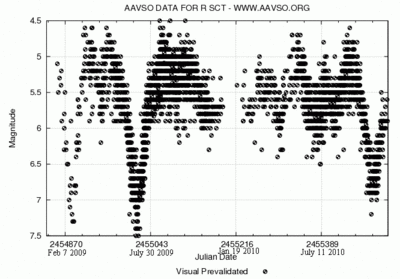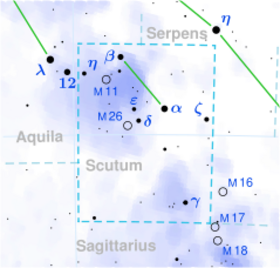Astronomy:R Scuti
| Observation data Equinox J2000.0]] (ICRS) | |
|---|---|
| Constellation | Scutum |
| Right ascension | 18h 47m 28.95s[1] |
| Declination | −05° 42′ 18.5″[1] |
| Apparent magnitude (V) | 4.2–8.6[2] |
| Characteristics | |
| Evolutionary stage | Asymptotic giant branch[3] |
| Spectral type | G0Iae-K2p(M3)Ibe[4] |
| U−B color index | 1.53[5] |
| B−V color index | 1.47[5] |
| Variable type | RV Tau[2] |
| Astrometry | |
| Radial velocity (Rv) | 43.80[6] km/s |
| Proper motion (μ) | RA: −45.399[7] mas/yr Dec.: −32.410[7] mas/yr |
| Parallax (π) | 0.8572 ± 0.2549[7] mas |
| Distance | approx. 4,000 ly (approx. 1,200 pc) |
| Absolute magnitude (MV) | ~ −2 – −3[8] |
| Details | |
| Mass | 0.55–0.68[9] M☉ |
| Radius | 84[3] R☉ |
| Luminosity | 5,000[3] - 9,400[10] L☉ |
| Surface gravity (log g) | 0.0[10] cgs |
| Temperature | 4,000[3] - 4,500[10] K |
| Metallicity [Fe/H] | –0.4[10] dex |
| Other designations | |
| Database references | |
| SIMBAD | data |
R Scuti (R Sct) is a star in the constellation of Scutum. It is a yellow supergiant and is a pulsating variable known as an RV Tauri variable. It was discovered in 1795 by Edward Pigott at a time when only a few variable stars were known to exist.[11]
Observation
R Sct is the brightest of the RV Tau-type stars[12] and the American Association of Variable Star Observers (AAVSO) contains over 110,000 observations of this star.[13] At its brightest it is visible to the naked eye, and at its dimmest can be located with good binoculars.[13] In the sky it is about 1 degree northwest of the Wild Duck Cluster (Messier 11).[13]
RV Tauri variables often have somewhat irregular light curves, both in amplitude and period, but R Scuti is extreme. It has one of the longest periods known for an RV Tau variable, and the light curve has a number of unusual features: occasional extreme minima; intermittent standstills with only small erratic variation that may last for years; and periods of chaotic brightness changes.[14][15]

Properties
The spectrum of R Scuti is peculiar, especially at cooler temperatures near the minima. In deep minima, much of the spectrum corresponds to an early K supergiant, but the spectrum also develops TiO bands more typical of an M-class star.[16]
The recognised spectral type of G0Iae-K2p(M3)Ibe gives an idea of the complexities of this star. Both the radius and temperature change, with maximum brightness corresponding to maximum temperature. The radius changes lag and the smallest size occurs about a quarter of the period after the minimum brightness.[4]
The spectral luminosity type classes R Sct as a supergiant, a bright supergiant (class Ia) near maximum, but it is actually thought to be a highly evolved and expanded low-mass star probably no more than 10,000 times the luminosity of the sun even at its brightest. The period-luminosity relation for type II Cepheids suggests a luminosity of 9300 L☉, similar to the spectrophotometric derivation at 9400 L☉.[8] Other derivations have produced much lower values, but often making unrealistic assumptions about the distance based on an obsolete Hipparcos parallax value.[8]
An extreme post-AGB star would be expected to show measurable secular changes in its temperature and period over the time that R Scuti has been closely observed. Instead a relatively low mass loss rate with an extended cool atmosphere and fairly constant temperature and period of variation is seen. One suggestion is that R Scuti is still a thermally pulsing AGB star, consistent with calculated levels of mass loss.[9]
The evolutionary status of R Scuti is uncertain and estimates of the mass vary wildly. RV Tau variables as post-AGB stars are expected to have masses near or below that of the sun and this is confirmed for a number of RV Tau stars in binary systems.[17] Old estimates based simply on the supergiant luminosity class gave much higher masses.[18]
See also
References
- ↑ 1.0 1.1 Van Leeuwen, F. (2007). "Validation of the new Hipparcos reduction". Astronomy and Astrophysics 474 (2): 653–664. doi:10.1051/0004-6361:20078357. Bibcode: 2007A&A...474..653V.
- ↑ 2.0 2.1 "GCVS Query=R Sct". General Catalogue of Variable Stars @ Sternberg Astronomical Institute, Moscow, Russia. http://www.sai.msu.su/gcvs/cgi-bin/search.cgi?search=R+Sct.
- ↑ 3.0 3.1 3.2 3.3 De Beck, E.; Decin, L.; De Koter, A.; Justtanont, K.; Verhoelst, T.; Kemper, F.; Menten, K. M. (2010). "Probing the mass-loss history of AGB and red supergiant stars from CO rotational line profiles. II. CO line survey of evolved stars: derivation of mass-loss rate formulae". Astronomy and Astrophysics 523: A18. doi:10.1051/0004-6361/200913771. A18. Bibcode: 2010A&A...523A..18D.
- ↑ 4.0 4.1 Shenton, M.; Monier, R.; Evans, A.; Carter, B. et al. (1994). "Multiwavelength observations of RV Tauri stars III. R Scuti". Astronomy and Astrophysics 287: 866. Bibcode: 1994A&A...287..866S.
- ↑ 5.0 5.1 Ducati, J. R. (2002). "VizieR Online Data Catalog: Catalogue of Stellar Photometry in Johnson's 11-color system". CDS/ADC Collection of Electronic Catalogues 2237: 0. Bibcode: 2002yCat.2237....0D.
- ↑ Gontcharov, G. A. (November 2006). "Pulkovo Compilation of Radial Velocities for 35 495 Hipparcos stars in a common system". Astronomy Letters 32 (11): 759–771. doi:10.1134/S1063773706110065. Bibcode: 2006AstL...32..759G.
- ↑ 7.0 7.1 7.2 Brown, A. G. A. (August 2018). "Gaia Data Release 2: Summary of the contents and survey properties". Astronomy & Astrophysics 616: A1. doi:10.1051/0004-6361/201833051. Bibcode: 2018A&A...616A...1G. Gaia DR2 record for this source at VizieR.
- ↑ 8.0 8.1 8.2 Kipper, Tõnu; Klochkova, Valentina G. (2013). "Peculiarities and Variations in the Optical Spectrum of the RV Tauri-type Star R Sct". Baltic Astronomy 22 (2): 77. doi:10.1515/astro-2017-0149. Bibcode: 2013BaltA..22...77K.
- ↑ 9.0 9.1 Matsuura, M.; Yamamura, Issei; Zijlstra, A. A.; Bedding, T. R. (2002). "The extended atmosphere and evolution of the RV Tau star, R Scuti". Astronomy and Astrophysics 387 (3): 1022. doi:10.1051/0004-6361:20020391. Bibcode: 2002A&A...387.1022M.
- ↑ 10.0 10.1 10.2 10.3 Ruyter, S; Winckel; Dominik; Waters et al. (2005). "Strong dust processing in circumstellar discs around 6 RV Tauri stars. Are dusty RV Tauri stars all binaries?". Astronomy and Astrophysics 435 (1): 161–166. doi:10.1051/0004-6361:20041989. Bibcode: 2005A&A...435..161D.
- ↑ Pigott, Edward; Englefield, Henry C. (1797). "On the Periodical Changes of Brightness of Two Fixed Stars. By Edward Pigott, Esq. Communicated by Sir Henry C. Englefield, Bart. F. R. S". Philosophical Transactions of the Royal Society of London 87: 133–141. doi:10.1098/rstl.1797.0007. Bibcode: 1797RSPT...87..133P. https://zenodo.org/record/1432300.
- ↑ "GCVS Type=RV". General Catalogue of Variable Stars @ Sternberg Astronomical Institute, Moscow, Russia. http://www.sai.msu.su/groups/cluster/gcvs/cgi-bin/typ.cgi?type=RV.
- ↑ 13.0 13.1 13.2 "R Scuti : A Favorite Among Its Class". AAVSO. http://www.aavso.org/vsots_rsct.
- ↑ Lebre, A.; Gillet, D. (1991). "The bright RV Tauri star R Scuti during an exceptional irregular light phase". Astronomy and Astrophysics 246: 490. Bibcode: 1991A&A...246..490L.
- ↑ Gillet, D. (1992). "On the origin of the alternating deep and shallow light minima in RV Tauri stars - R Scuti and AC Herculis". Astronomy and Astrophysics 259: 215. Bibcode: 1992A&A...259..215G.
- ↑ Bopp, B. W.; Howell, S. B. (1982). "The Remarkable Spectrum of the RV Tauri Star R Souti at Deep Minimum". Bulletin of the American Astronomical Society 14 (572): 762–767. Bibcode: 1982BAAS...14Q.880B.
- ↑ Harris, Hugh C.; Welch, Douglas L. (1989). "The Binary Type II Cepheids IX CAS and TX Del". Astronomical Journal 98: 981. doi:10.1086/115190. Bibcode: 1989AJ.....98..981H.
- ↑ Robert Burnham (1978). Burnham's celestial handbook : an observer's guide to the Universe beyond the solar system. New York: Dover Publications. ISBN 0486318036. https://archive.org/details/burnhamscelestia02robe.
External links
- AAVSO: Quick Look View of AAVSO Observations (get recent magnitude estimates for R Sct)
 |


